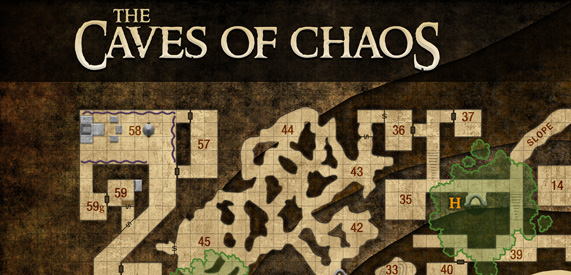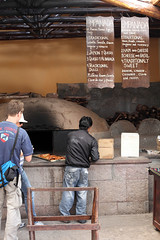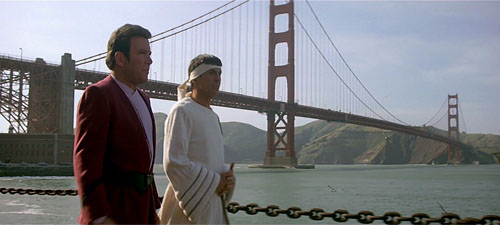 Like the movie before it, Star Trek IV: The Voyage Home is a direct continuation of the previous instalment in the series. It opens with a recap of the previous two films, followed by an upbeat musical theme over the main titles. This music has distinctive glockenspiel notes in it, twinkling in the manner of stars in space – a nice effect.
Like the movie before it, Star Trek IV: The Voyage Home is a direct continuation of the previous instalment in the series. It opens with a recap of the previous two films, followed by an upbeat musical theme over the main titles. This music has distinctive glockenspiel notes in it, twinkling in the manner of stars in space – a nice effect.
The opening scenes show a mysterious black cylinder moving through space past the USS Saratoga, which reports it’s headed straight for Earth, in an eerie mirror of V-ger in Star Trek: The Motion Picture. Then we cut to Starfleet headquarters on Earth, where the Klingon ambassador is calling for Kirk to be extradited and tried for destroying a Klingon vessel and crew (in the previous film). During this accusal we are treated yet again to the Genesis computer graphics created for Star Trek II: The Wrath of Khan and repeated in Star Trek III: The Search for Spock, since in 1986 they still looked impressive. Sarek argues in Kirk’s defence.
On Vulcan, Kirk and his crew are banging the captured Klingon bird-of-prey from the last movie into shape for the trip back to Earth to face the consequences of stealing the Enterprise in the previous movie. They lampshade the rather silly predicament that Starfleet hasn’t bothered to send a better ship to pick them up and take them back to Earth for court martial. Spock is still rebuilding his intellect after his brush with death and we see him studying with some computers asking him tricky questions, when one asks, “How do you feel?” Spock is stumped, and his mother appears and reveals she programmed the computers to ask him this, to remind him of his human heritage. Spock takes his leave without answering her and elects to return to Earth to face trial with his colleagues.
Back at Earth, the mysterious probe arrives and starts vapourising the oceans. Things rapidly deteriorate, to the point where the President of the Federation issues a distress call, stating that the probe has “almost totally ionised the atmosphere“! (While this is possible, everything on Earth would be dead already.) When our heroes arrive, they cleverly figure out that the probe is transmitting sound into the Earth’s oceans. Modifying the sound to what it would sound like underwater, Spock recognises it as whale song. They quickly realise that the probe must have come to investigate why the sounds of whales ceased coming from Earth a couple of hundred years ago – when they died out. To respond and stop the probe, they need whales. Thus is hatched a hare-brained scheme to travel back in time to before they became extinct and pick some up!
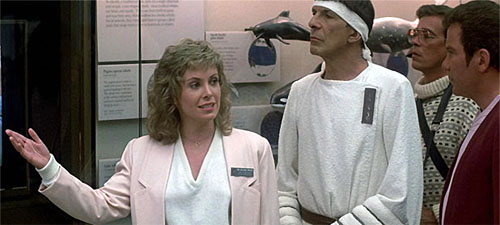 We are treated to some trippy mind-screw hallucinatory images as the Klingon ship slingshots around the sun and is flung back to… 1986! Uhura reports that she is “receiving whalesong!” One wonders how the whales are transmitting it into space – presumably through the same means they use to communicate with the mysterious probe’s civilisation. They land in Golden Gate Park in San Francisco, with the ship cloaked – thus explaining why they had to retain the Klingon ship, since Federation vessels don’t have cloaking technology. Interestingly, in the previous movie, the cloaking device on this same ship produced a rippling effect against the background stars in space that allowed Sulu to see the ship anyway, but now it produces complete and utterly flawless invisibility. Presumably Scotty did some of his magical engineering tweaks on it to improve it.
We are treated to some trippy mind-screw hallucinatory images as the Klingon ship slingshots around the sun and is flung back to… 1986! Uhura reports that she is “receiving whalesong!” One wonders how the whales are transmitting it into space – presumably through the same means they use to communicate with the mysterious probe’s civilisation. They land in Golden Gate Park in San Francisco, with the ship cloaked – thus explaining why they had to retain the Klingon ship, since Federation vessels don’t have cloaking technology. Interestingly, in the previous movie, the cloaking device on this same ship produced a rippling effect against the background stars in space that allowed Sulu to see the ship anyway, but now it produces complete and utterly flawless invisibility. Presumably Scotty did some of his magical engineering tweaks on it to improve it.
In town, this being San Francisco, nobody comments on their weird 23rd century clothing, especially Spock’s nightrobe-like Vulcan garb. Kirk is shocked to learn the natives are “still using money”. He sells the antique pair of glasses McCoy gave him at the beginning of Star Trek II. When Spock protests that they were a gift from McCoy, Kirk says, “That’s the beauty of it, they will be again,” implying the glasses enter a stable time loop. The group splits up, Kirk and Spock to look for whales, Scotty and McCoy to find some materials to build a whale tank inside the ship, Sulu to arrange transport for the materials, and Uhura and Chekov to locate a nuclear reactor so they can scavenge some high energy photons to recharge the ship’s warp engines. Scotty also generates a time loop when he teaches a materials scientist how to make transparent aluminium in exchange for some plexiglass. When McCoy protests that he could be messing with history, Scotty rather flippantly dismisses him with, “How do we know he didn’t invent it?” This is dealt with better in the novelisation, in which Scotty recognises the man as the guy who actually did invent transparent aluminium, thus reducing the flippant disregard for creating a time paradox.
Kirk and Spock find some whales at a fictional Cetacean Institute in Sausolito, as well as their carer Gillian. Kirk woos Gillian and eventually tells her they are from the future and need the whales. She rejects him, but comes back to find him when her boss releases the whales into the open sea, where they will be hunted and killed by whalers. Meanwhile, Uhura and Chekov locate a reactor, on board the aircraft carrier USS Enterprise(!), and beam in, getting into trouble when Chekov, a Russian, is caught inside an American naval vessel, at the height of the Cold War. He tries to escape but is injured and rushed to hospital, where the others stage a rescue mission. Then they fly out with Gillian on board to locate the whales’ tracking devices. They find them just before they are about to be harpooned by some evil Scandinavians, beam them aboard into the tank, and fly home to the future.
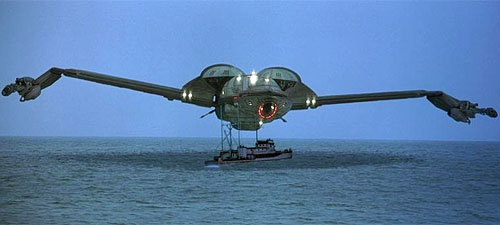 There they release the whales into San Francisco Bay to repopulate the species, the probe is happy and departs, and the Earth is saved! At the court martial, all charges are dropped due to extenuating circumstances, except the charge against Kirk of disobeying orders, for which he is demoted from Admiral to Captain, and therefore given command of a ship. The Klingon ambassador is outraged and Sarek is smug. Spock tells Sarek to tell his mother, “I feel fine.” The crew head to their new ship… which is revealed to be a brand new Enterprise. Awwww.
There they release the whales into San Francisco Bay to repopulate the species, the probe is happy and departs, and the Earth is saved! At the court martial, all charges are dropped due to extenuating circumstances, except the charge against Kirk of disobeying orders, for which he is demoted from Admiral to Captain, and therefore given command of a ship. The Klingon ambassador is outraged and Sarek is smug. Spock tells Sarek to tell his mother, “I feel fine.” The crew head to their new ship… which is revealed to be a brand new Enterprise. Awwww.
This is a very different Trek movie, which played more heavily with humour and light-hearted action than drama. And it worked, it really did. Some of the comedy moments with Kirk and Spock in the 20th century are truly hilarious, pushing but never quite falling into slapstick and ridiculousness. It’s an incredibly fun story, which is ultimately uplifting and hopeful – just what we needed in the dark and pessimistic times of the mid 1980s. Star Trek as it was truly meant to be. Wrath of Khan is a more edgy, dramatic, tense, and probably better movie, but this one is way more fun, and easily my second favourite of the entire series.
Tropes: Big Dumb Object, Ass in Ambassador, Lampshade Hanging, Artistic Licence – Physics, Crazy Enough to Work, Space Whale, Space Whale Aesop, Changed My Jumper, Stable Time Loop, Time Travel Romance, Mistaken for Spies, Time Travellers Are Spies, Adam and Eve Plot, Green Aesop, Unishment, Fish Out of Temporal Water, Everybody Lives.
Body count: None!

 Like the movie before it,
Like the movie before it,  We are treated to some trippy mind-screw hallucinatory images as the Klingon ship slingshots around the sun and is flung back to… 1986! Uhura reports that she is “receiving whalesong!” One wonders how the whales are transmitting it into space – presumably through the same means they use to communicate with the mysterious probe’s civilisation. They land in Golden Gate Park in San Francisco, with the ship cloaked – thus explaining why they had to retain the Klingon ship, since Federation vessels don’t have cloaking technology. Interestingly, in the previous movie, the cloaking device on this same ship produced a rippling effect against the background stars in space that allowed Sulu to see the ship anyway, but now it produces complete and utterly flawless invisibility. Presumably Scotty did some of his magical engineering tweaks on it to improve it.
We are treated to some trippy mind-screw hallucinatory images as the Klingon ship slingshots around the sun and is flung back to… 1986! Uhura reports that she is “receiving whalesong!” One wonders how the whales are transmitting it into space – presumably through the same means they use to communicate with the mysterious probe’s civilisation. They land in Golden Gate Park in San Francisco, with the ship cloaked – thus explaining why they had to retain the Klingon ship, since Federation vessels don’t have cloaking technology. Interestingly, in the previous movie, the cloaking device on this same ship produced a rippling effect against the background stars in space that allowed Sulu to see the ship anyway, but now it produces complete and utterly flawless invisibility. Presumably Scotty did some of his magical engineering tweaks on it to improve it. There they release the whales into San Francisco Bay to
There they release the whales into San Francisco Bay to 